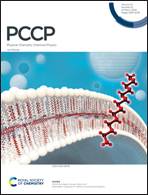Understanding the effects of the co-sensitizing ratio on the surface potential, electron injection efficiency, and Förster resonance energy transfer†
Abstract
Multiple absorbers that function in different absorption regions (near infra-red (NIR) and UV-Visible (UV-Vis)) have been widely used in solar cell applications to enhance the light-harvesting. Herein, two special co-sensitizing Models 1 and 2, which feature either saturated dye IQ21 or saturated co-sensitizer S2, have been added to a TiO2 surface to explore the effect of the altered sensitizing sequence, namely the co-sensitizing ratio of IQ21/S2 and S2/IQ21 on the electrostatic potential variation (ΔV), electron injection efficiency (ηinj′), and Förster resonance energy transfer (FRET), using density functional theory and first-principle molecular dynamics simulations. The ΔV related to the open-circuit voltage (Voc) is insensitive in both Models 1 and 2. However, the absorption (λabs) and ηinj′ associated with the short-circuit density (Jsc) display a significant deviation (the λabs for 1 is red-shifted compared to that of 2, and the ηinj′ for 1 is improved by 56%). Meanwhile, Model 1 manifests a suppressed FRET and potentially favors co-sensitizer S2 functioning as the electron-injector and not the energy-donor. Another two possible Models 3 and 4 that feature a reduced adsorption of IQ21 and S2 relative to 1 and 2 were considered further, and the result mirrors the main trend in 1 and 2, except for the ηinj′. Overall, it implies that sensitizing a larger absorber with NIR features to saturate it first, then introducing a smaller absorber with UV-Vis features, can potentially improve the electron injection and diminish electron–hole recombination considerably. Our results provide a comprehensive analysis of the active role of an optimized sensitizing sequence to improve the conversion efficiency.



 Please wait while we load your content...
Please wait while we load your content...